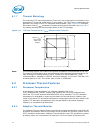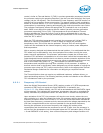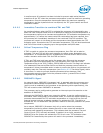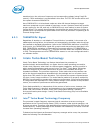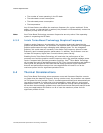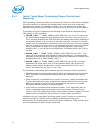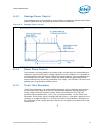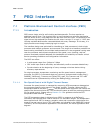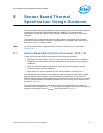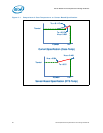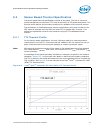
Thermal Specifications
60 Thermal/Mechanical Specifications and Design Guidelines
6.4.1 Intel
®
Turbo Boost Technology Power Control and
Reporting
When operating in the turbo mode, the processor will monitor its own power and adjust
the turbo frequency to maintain the average power within limits over a thermally
significant time period. The package, processor core, and graphic core powers are
estimated using architectural counters and do not rely on any input from the platform.
The behavior of turbo is dictated by the following controls that are accessible using
MSR, MMIO, or PECI interfaces:
• POWER_LIMIT_1: TURBO_POWER_LIMIT, MSR 610h, bits 14:0. This value sets
the exponentially weighted moving average power limit over a long time period.
This is normally aligned to the TDP of the part and steady-state cooling capability of
the thermal solution. This limit may be set lower than TDP, real-time, for specific
needs, such as responding to a thermal event. If set lower than TDP, the processor
may not be able to honor this limit for all workloads since this control only applies
in the turbo frequency range; a very high powered application may exceed
POWER_LIMIT_1, even at non-turbo frequencies. The default value is the TDP for
the SKU.
• POWER_LIMIT_1_TIME: TURBO _POWER_LIMIT, MSR 610h, bits 23:17. This
value is a time parameter that adjusts the algorithm behavior. The exponentially
weighted moving average turbo algorithm will use this parameter to maintain time
averaged power at or below POWER_LIMIT_1.
• POWER_LIMIT_2: TURBO_POWER_LIMIT, MSR 610h, bits 46:32. This value
establishes the upper power limit of turbo operation above TDP, primarily for
platform power supply considerations. Power may exceed this limit for up to
10 mS. The default for this limit is 1.25 x TDP.
The following considerations and limitations apply to the power monitoring feature:
• Calibration applies to the processor family and is not conducted on a part-by-part
basis. Therefore, some difference between actual and reported power may be
observed.
• Power monitoring is calibrated with a variety of common, realistic workloads near
Tj_max. Workloads with power characteristic markedly different from those used
during the calibration process or lower temperatures may result in increased
differences between actual and estimated power.
• In the event an uncharacterized workload or power “virus” application were to
result in exceeding programmed power limits, the processor Thermal Control
Circuitry (TCC) will protect the processor when properly enabled. Adaptive Thermal
Monitor must be enabled for the processor to remain within specification.
Illustration of Intel Turbo Boost Technology power control is shown in the following
sections and figures. Multiple controls operate simultaneously allowing for
customization for multiple system thermal and power limitations. These controls allow
for turbo optimizations within system constraints.





